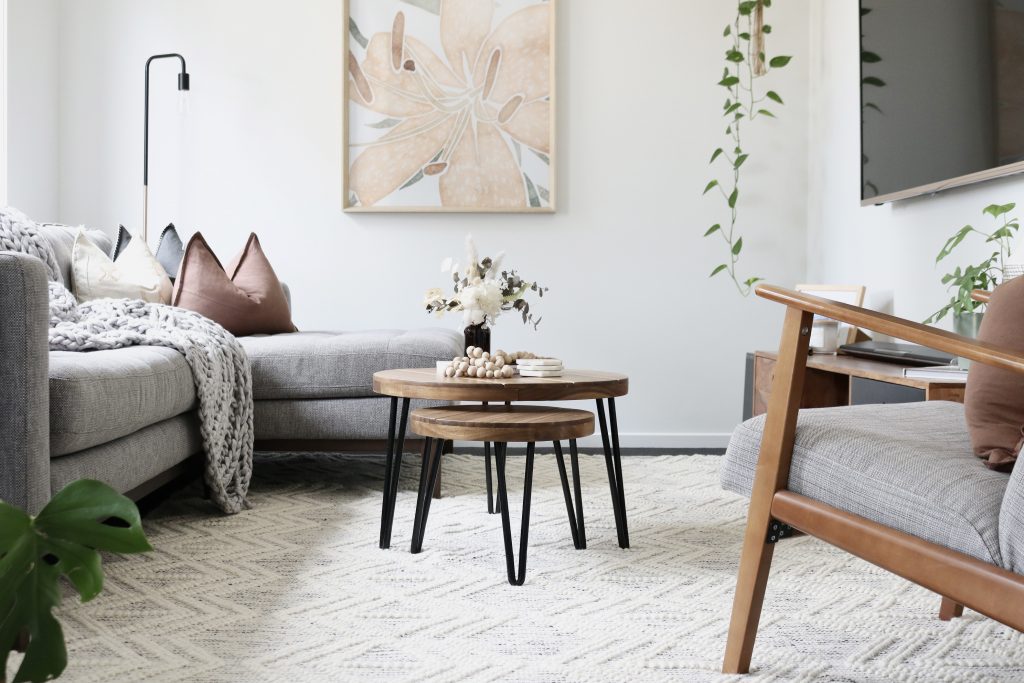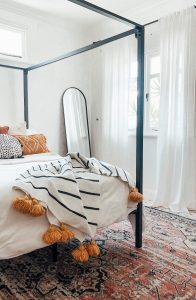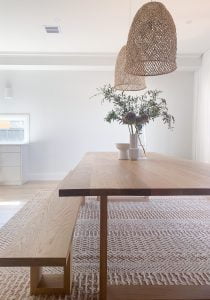Decorating with Rugs by Kate Bastain & Rebecca Keast – Six Fourteen
More often than not, a rug is an afterthought when it comes to interior decorating – even though they are often one of the largest pieces in a space when looking at the surface area. It’s really no surprise then that choosing the right rug can transform a room, changing the look and feel of the space. A rug is therefore a great starting point when working with a blank canvas.
There are three key points to consider when selecting the right rug for a room:
1. Size and Shape
2. Colour and Pattern
3. Fibre
Getting these 3 components right will help to build a cohesive, functional as well as visually pleasing space, from the ground up.
1. Size and Shape
In good design, scale is very important, so it is necessary to take into consideration the dimensions of the space as well as the furniture that will sit on and around it when choosing a rug. Think of it as an anchoring point that brings your later chosen pieces together. By selecting the largest size rug possible you can for a space, it can help create a luxe feel and actually make the room appear larger. However, it’s still important that the rug look like a rug, so whilst selecting the largest option possible, it is important to leave a “border” so that the rug doesn’t look like a wall-to-wall carpet. We suggest leaving at least 25cm (but up to 65 if you have the space) from the wall to the edge of the rug. This is the first of many “rug rules” that can apply to each room in the home.

When selecting the right size rug for a lounge room it should generally define the area. This is particularly important in open plan spaces where rugs can be used to delineate areas for different uses. Ideally all lounges and or seats as well as coffee tables or footstools should be on the rug, grounding the space and creating a defined lounge area. A good rule of thumb is to have a rug 10-20cm wider than the sofa (don’t forget to take side tables into account if necessary!). If it isn’t possible to have all the “conversational” furniture on the rug, at least the front legs of the lounge and or chairs should sit on the rug to ground the space. Whilst a floating rug where no furniture sits on the rug can work, it does not give the same unified look and is much harder to pull off. If a client has a rug that they simply love and has to be worked into a brief, layering is a great option that can help to ensure the best dimensions are achieved.

A rug in the bedroom is the ultimate luxury underfoot and a great grounding tool visually. It is also a great option to add texture, colour and pattern. When it comes to selecting the right size rug in a bedroom, it is important to have enough space on either side of the bed to step out onto the rug, with a reasonable margin at the end of the bed. As a general rule we suggest a 320×230 for under a queen sized bed or larger if space allows. If a space won’t allow for a full sized rug dual runners on either side of the bed is a great option. An offset round rug for a room with a single bed can be a great choice, breaking up and softening the straight lines.

A rug under a dining table is a personal choice and not for everyone. Should you wish to pursue this option, it is essential to get the size right to prevent a top-heavy look and also to prevent chairs getting stuck on the edges of the rug. We recommend adding 120cm to the length and 120cm to the width of a rectangular/square table and 120cm to the diameter of a round table. This will give 60cm for each chair to pull out without coming off the edge of the rug. For example, for a 110cmx200cm table the recommended rug size would be 220cmx320cm. Careful consideration of fibre is important for a rug under a dining table, not only for the more obvious spills and stains but also for the movement of chairs to ensure stretching and pulling don’t age a rug before its time.
2. Colour and Pattern
Colour and pattern in a rug are often used to underscore the style in the space. They are a great jumping off point to set up the intended overall design aesthetic. From sleek contemporary options to more traditional patterned rugs, right through to tribal shag pieces more suited to a boho or tribal design, there is always a rug to suit. The “safe” option is always to stick to a more subdued tone in something as large as a rug, however going for something with a more bold colour and/or pattern can be an excellent way to make a true design statement, if the brief and space are right.
READ: 5 Interesting Facts about Colour that Will Help You in Your Day to Day Life
3. Fibre
When it comes to deciding on the right fibre for a space, there are a number of important questions that need to be answered before decisions are made: Will it be a high traffic area? Who will be using the space eg. children and/or pets? Is this a high traffic area or is it a more formal space where there will be limited foot traffic? Once these questions have been answered looking at the pros and cons of the different fibres can help in the decision as to what to go for. Man-made fibres are an excellent affordable option that are non-shed and relatively easy to clean. The nature of the fibre means they don’t absorb liquids quickly making spills easy to mop up. They can also be more vigorously vacuumed, which make them a great option in a family home. Wool rugs on the other hand require more gentle treatment in the vacuum department and do shed, however they have excellent fibre resilience and provide excellent insulation, whilst also having the benefit of lower flammability. Then there is of course the beauty of a jute rug. Cool and silky underfoot, with a resilient fibre structure they are a great option on their own or for layering. They just need to be in nice dry areas and as dyed jute is often not colourfast in bright sunlight this is also an important consideration. With each fibre having their own array of piles and finishes from shag to power loomed to hand braided and everything in-between, there is a rug to suit every design style.
It’s easy to see that styling with rugs can ultimately determine the overall style and feel of a space. With scale, texture, colour, pattern, relationship to other furnishings and intended use all playing a major part in determining which rug to go for, it’s easy to see why rugs are a great place to start when creating a new design concept. So, whatever the style, shape or size of a space, there’s a rug and a “rule” to help get the look underfoot.
Post by Kate Bastain and Rebecca Keast of Six Fourteen.
ISCD has a 40-year proven track record of producing leading Australian interior designers. We know design intimately, from colour theory, to furniture selection to the latest industry trends.
Are you interested in studying interior design or decoration? Do you want to know more about our online courses and where a career in interior design could take you? Connect with us today to learn more about our Diploma of Interior Design, the Certificate IV in Interior Decoration or any of our industry-focused microcredentials.